|
|
|
Hansen's Northwest Native Plant Database |
|
|
|
Cornus nuttallii (Pacific
Dogwood)
|
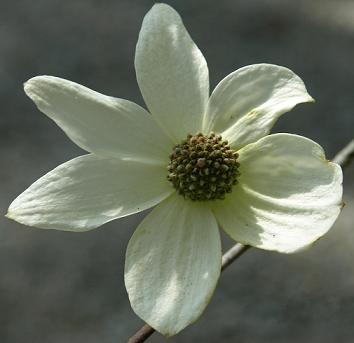 |
|||||||||||||||||||||||||||||||
|
||||||||||||||||||||||||||||||||
|
Plant Brief: A beautiful tree, the Pacific Dogwood is native along the western coast from BC to California and in the California mountains, in USDA zones 6-7. A moderate grower, Pacific Dogwood will reach at least 20 and often develops multiple stems. The branches become laden with brilliant white flowers in spring and sometimes again in late summer. The creamy-white flowers consist of four petal-like bracts, each 3 long. In the fall, the foliage is a pleasing yellow or red. This excellent shade tree requires rich, well-drained soil and will thrive in partial shade. A little pampering in the first few seasons will be rewarded with lush growth and plenty of blooms. Place a specimen tree or grouping of Pacific Dogwood in every native garden where the bright flowers serve as a beacon of white against dark conifers. |
||||||||||||||||||||||||||||||||
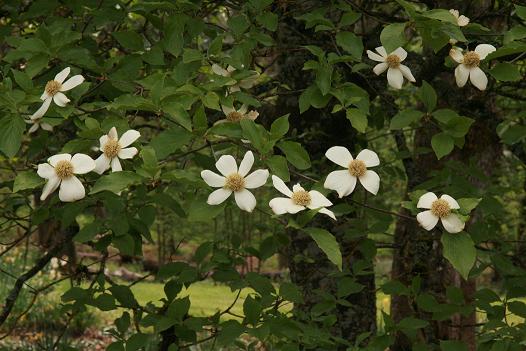 |
Description: There is something magical about the Pacific Dogwood regardless of what time of year it is. In the landscape, the tree is prized for its interesting and irregular form, large white blooms, pleasing autumn color and bright red fruit. Pacific Dogwood brings an unrivaled elegance and light to the northwest forest canopy, and it just might be able to do the same for your own garden. Pacific Dogwood is a deciduous, and long-lived flowering tree that usually grows to heights of 20 to 30 feet in the garden, although it has been found to reach 65 feet in the most optimum of natural sites. |
|||||||||||||||||||||||||||||||
|
Flowers appear April to June, and occasionally again in August or September. Each bloom of the Pacific Dogwood is actually comprised of a cluster of many, very small, greenish flowers surrounded by six creamy white petal-like bracts (the number of bracts may vary from four to seven). By autumn, these clusters of tiny flowers have transformed into clusters of bright red drupes (fruit), each about half an inch in length. |
||||||||||||||||||||||||||||||||
|
The leaves of the Pacific Dogwood are three to five inches long and elliptical, with slightly wavy edges. They are green or deep green and slightly shiny on top with paler undersides. Leaf veins are in opposite pairs and curve out and along the leaf in parallel. Autumn color tends to be some shade of red (some are yellow-red, others pink-red, and still others are orange-red). While the leaves are opposite, they often appear whorled when growing at the ends of branchlets. These branchlets are green when young, but turn a dark reddish-purple when mature. The bark of the Pacific Dogwood is thin, gray and smooth, but it often breaks into rectangular scales with age. Habitat and Range: The native range of the Pacific Dogwood extends from southern British Columbia to southern California. It is found along the Pacific coast and inland about 200 miles; at lower elevations from British Columbia through northern California and at higher elevations in southern California. A disjunctive population exists in north-central Idaho. |
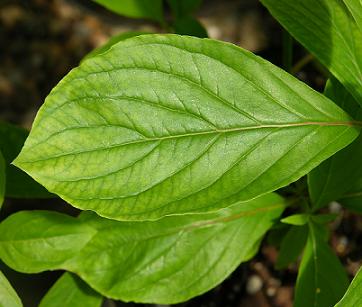 |
|||||||||||||||||||||||||||||||
|
The Pacific Dogwood is fairly unique among hardwoods as it is able to photosynthesize in just one-third full sunlight. The tree is often found growing in the partial to full shade conditions of mixed and coniferous forests, though it may not fruit in deep shade. The thin bark of the trunk is prone to sunburn and frost, and young trees rely on understory shrubs for shade and protection while older trees are more protected by their larger, denser canopy. For this reason, mature trees are more accepting of open, sunny sites. |
||||||||||||||||||||||||||||||||
|
The Pacific Dogwood prefers soil that is moist, deep, relatively stone-free, well-drained and high in organic matter and nitrogen. It also appears to prefer soil that has an average late-summer temperature in the low 50s. Established trees are drought resistant and generally do not require summer watering. Pacific Dogwoods are primarily found growing amongst a canopy of the following: Douglas Fir (Pseudotsuga menziesii), Grand Fir (Abies grandis), Western Hemlock (Tsuga heterophylla), Giant Sequoia (Sequoiadendron giganteum), Coast Redwood (Sequoia sempervirens), and Giant Chinkapin (Chrysolepis chrysophylla var. chrysophylla). Common understory companions include Pacific rhododendron (Rhododendron macrophyllum), Oceanspray (Holodiscus discolor), Snowberry (Symphoricarpos albus), and Pacific Bayberry (Myrica californica). Native Plant Gardening: The Pacific Dogwood can be difficult to grow successfully in the garden, but the reward is great. Careful attention should be paid to ensure the soil is rich, deep, and well-drained. New trees should be planted amongst shrubs so that the trunk is shaded, while upper branches receive light. |
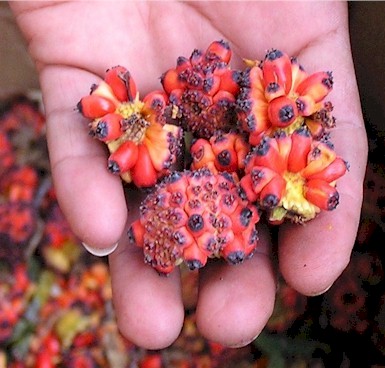 |
|||||||||||||||||||||||||||||||
|
The soil within a few inches of the tree should not be disturbed, mounded or compacted, and care should also be taken to protect the thin bark from damage by lawn equipment. These wounds may enable a destructive fungus to enter the tree (discussed in a later section). |
||||||||||||||||||||||||||||||||
|
When in bloom, the Pacific Dogwood is a truly stunning site. Their love of shady locations makes them perfect for brightening a dark area of the garden, and they look equally wonderful as a single specimen tree or in a grove of multiple trees. If you have a stand of evergreens, place a dogwood where you can admire the blooms against the dark background. Shade the trunk with understory plants that occur with the Pacific dogwood in the wild, such as those listed just above. Trees should not be pruned for purposes of shaping, but instead should be left to develop their own style. This will help protect the health of the tree. Wildlife Habitat: Deer may browse the young twigs of the Pacific Dogwood, but generally, they are not a major food source due to their high concentration of tannins and, therefore, bitter taste. Bears and beavers will eat the fruit and foliage. Birds, the band-tailed pigeon in particular, eat the fruit of the Pacific Dogwood, which matures in September and October. The tree also serves as a host to butterfly caterpillars. Historical and Cultural Uses: The wood of the Pacific Dogwood is very hard and close-grained. It was used by the Native Americans to make salmon harpoons, bows, arrows, tool handles, clothing hooks, combs, needles and knitting needles. The bark would also be used to make a dark brown dye, and the roots were used to make a red dye. Early settlers used the wood for mauls and mallet heads. |
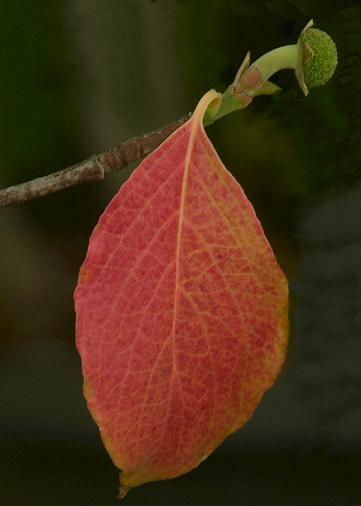 |
|||||||||||||||||||||||||||||||
|
The Pacific Dogwood has also been used for several medicinal purposes. The bark contains quinine, and tea made from the bark was used as a diarrheic, to treat fevers and problems with the stomach and liver, to promote the appetite, and to purify the blood and strengthen the lungs. It was also occasionally used as a treatment for malaria. The bark also has a slight antiseptic quality, and it was sometimes used to treat sores and inflammation of the skin. NOTE: Please use caution when preparing or eating any parts of a plant. Identification of the species and knowledge of a plants toxicity are both essential before using any plant species medicinally or otherwise. Please consult with a health professional before attempting to treat any ailment. |
||||||||||||||||||||||||||||||||
|
Propagation Techniques: The Pacific Dogwood can be propagated by seed, cuttings and layering. To propagate from seed, fruit should be collected as soon as mature and planted either as is or with the pulp removed. Seed will germinate within a few weeks in a variety of conditions. Some success may be achieved by layering small branches or by taking cuttings of new growth from the root crown in June and July. Prior to planting out, saplings should be kept in clay pots to prevent root rot. Saplings should be planted out within two years to enable proper development of the taproot. Saplings kept in pots longer than two years are less likely to survive. |
|
Issued in 1998, this stamp celebrates our northwest native dogwood tree.
|
||||||||||||||||||||||||||||||
|
Common Diseases: The Pacific Dogwood is susceptible to a fungal disease that can result in leaf spot, trunk cankers, branch dieback and possibly the premature death of the tree. The disease, known as dogwood anthracnose, is caused by the Discula destructiva fungus. It is most likely to attack trees during cool, wet weather. Symptoms tend to appear on the lower part of the tree first. Tan spots and large blotches may appear on the leaves and bracts, and veins and leaf edges may turn brown. Trees will drop affected leaves prematurely in the spring. Cankers may appear on the trunk at the base of affected branches. Trees that are being attacked by the fungus may send up numerous new shoots from the trunk and large limbs. |
||||||||||||||||||||||||||||||||
|
While there is little conclusive advice on how to treat the disease, the following may help prevent infection:
If the tree has been diagnosed with dogwood anthracnose, a fungicide may be applied. Refer to the American Phytopathological Society for more information: http://www.apsnet.org/media/press/archive/dogwood.asp. |
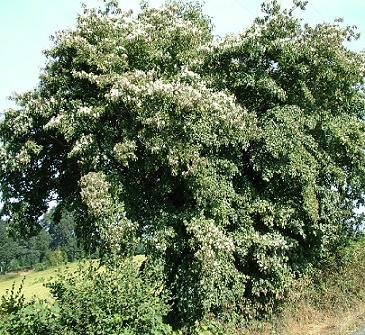 This wild specimen is blooming for the second time in the year. |
|||||||||||||||||||||||||||||||
|
Photos We Share!
|
|||||||||||||||||||||||||||||||
Resources:
|
||||||||||||||||||||||||||||||||
|